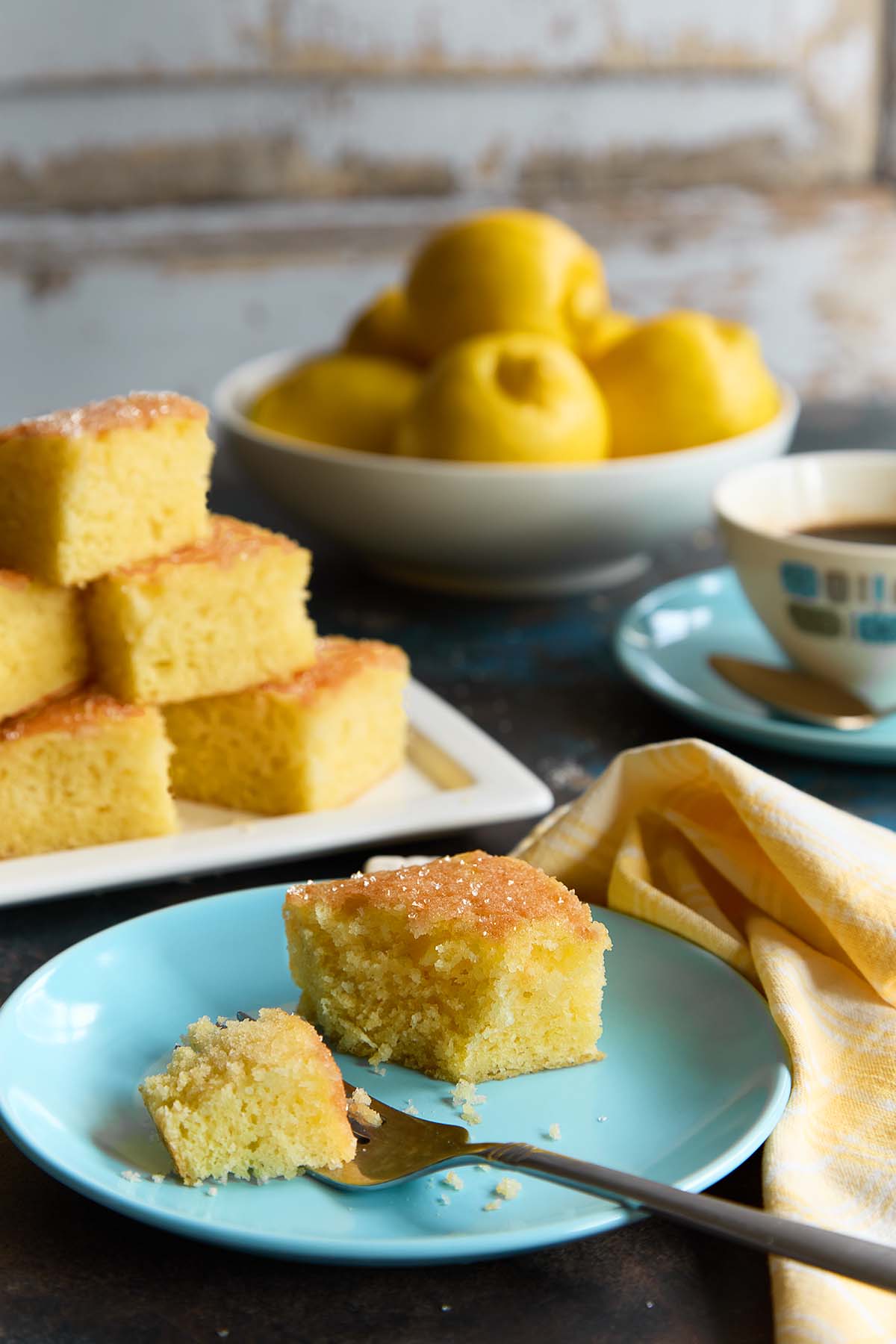
Everyone needs a great lemon drizzle cake, or lemon snacking cake, in their back pocket. One that’s rippling with sweet-tart lemon flavor and tender as can be. And this cake fits the bill.
I initially turned to the lemon drizzle cake by Paul Hollywood, which was on this site, but I discovered it wasn’t reliable. (Sorry, ole blue eyes.) Sometimes, the middle collapsed; other times, it domed like a mountain. So I removed it.
That’s when I went on a hunt for a replacement. But nearly every British recipe I made (because the drizzle cake is, by definition, a British treat) turned out a dry, dense cake. I was on my fifth recipe when I realized the issue: English plain flour tends to be lower in protein than U.S. all-purpose flour (plain flour: 9–10% vs. U.S. all-purpose: 10.5–12%), depending on the brand. On top of that, U.S. all-purpose flour absorbs more liquid than English plain flour, hence the dryness.
So, I turned to cake flour, which has a lower protein content of just 6–8%. According to King Arthur Baking, this lower protein level gives cakes a finer, more tender crumb—exactly what I was after.
I was halfway there, but the fact that all the British recipes called for self-rising flour bugged me. It’s not that easy to find here in the States, and it varies by brand. So, I reverse-engineered it so that my recipe calls for precise amounts of cake flour, baking powder, and salt. Period.
And that did the trick. A plush, tender, sweet-tart cake that, in my not-so-humble opinion, bested all the other recipes I tried. I hope you agree!
Chow,


Why This Recipe Works
This lemon drizzle cake is everything a great tea cake should be—bright, tender, and unapologetically lemony. The balance of flavor and texture is key here. Rubbing the lemon zest into the sugar releases its fragrant oils, infusing every bite with citrusy goodness before the batter even hits the pan.
Using cake flour gives the cake a more delicate crumb, while a bit of sour cream adds moisture, richness, and a bit of a tang without weighing it down. The result? A plush, buttery interior that holds together beautifully when sliced, but still melts in your mouth.
Then comes the magic: a tangy-sweet lemon syrup, poured over the still-warm cake, soaks into the crumb, creating that signature crackly top and locking in moisture. A final sprinkle of sanding sugar gives it a subtle crunch and a little sparkle—because why not?
Notes on Ingredients

- Unsalted butter—The butter lends richness and moisture to the cake, helping create that soft, tender crumb. Make sure it’s fully softened before creaming so it incorporates evenly with the sugar for a light, fluffy batter.
- Granulated sugar—Sugar sweetens the cake and forms the base for the lemon syrup topping. Rubbing it with the zest releases citrus oils that infuse every bite with bright lemon flavor.
- Cake flour and baking powder—Cake flour gives the cake its delicate, fine crumb, while baking powder helps it rise beautifully. If using all-purpose flour, expect a slightly denser and slightly drier texture.
- Eggs—The yolks and whites provide structure, richness, and a bit of lift. Use large eggs at room temperature so they emulsify smoothly into the batter without curdling.
- Lemon—The star of the show. Both the zest and juice bring a bold, tangy brightness to the cake and syrup. Use fresh, unwaxed lemons and zest before juicing for maximum flavor.
- Sour cream—A small amount of sour cream makes the cake extra tender and adds just enough tang to balance the sweetness. Whole milk can be used in a pinch, but the texture won’t be quite as plush.
How to Make This Recipe
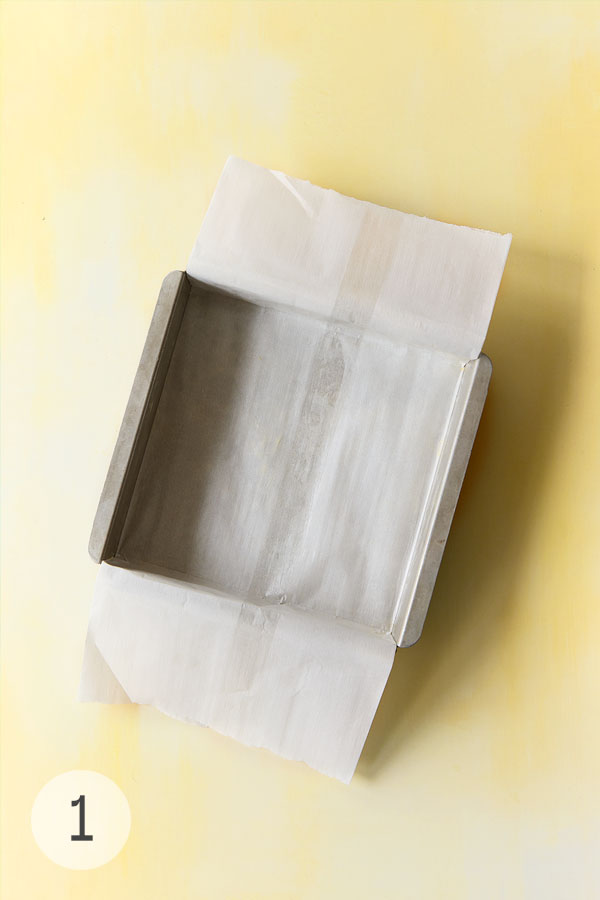
- Butter an 8-inch square cake pan and line it with parchment, leaving a bit of overhang so you can lift the cake out easily later.
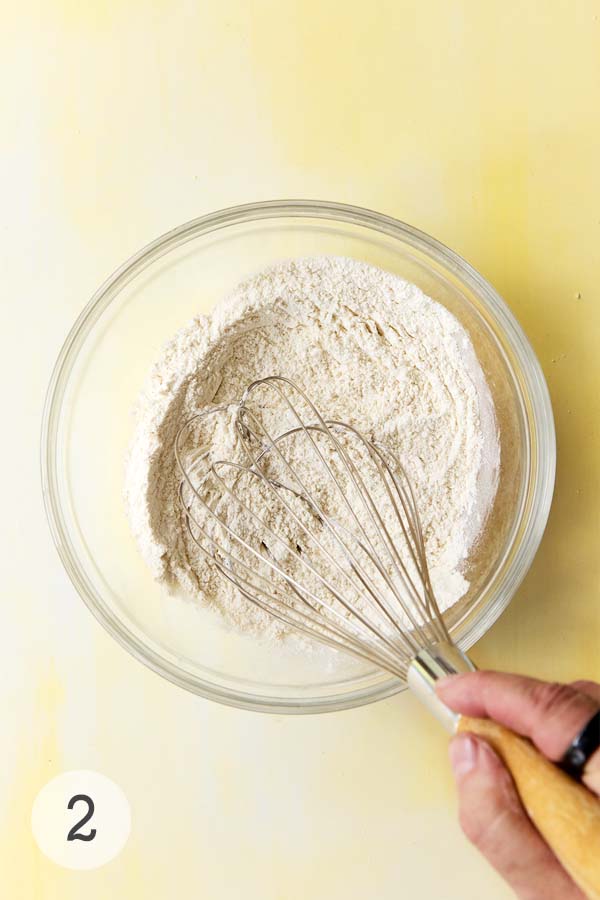
- Whisk together the cake flour, baking powder, and salt. This evenly distributes the leavening so the cake rises light and even.
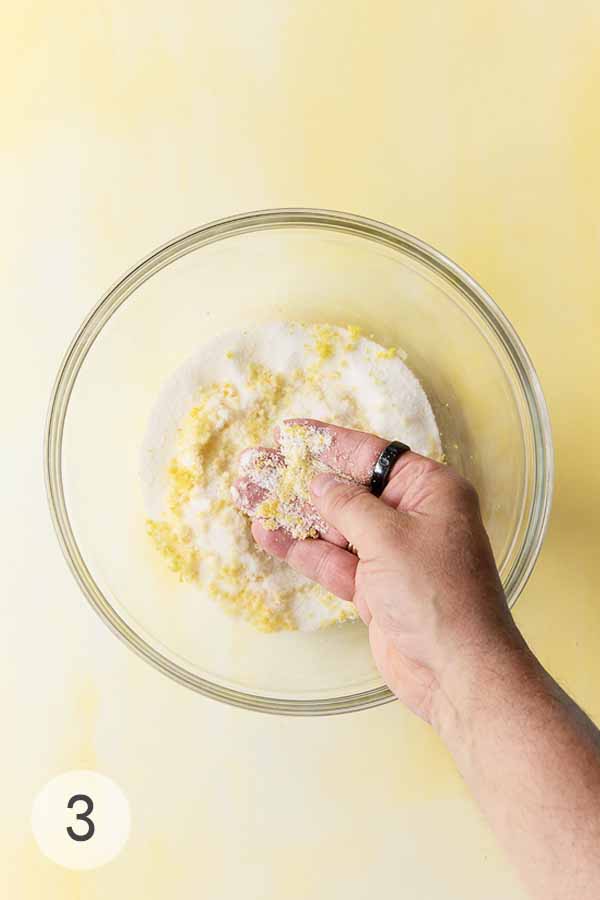
- Rub the lemon zest into the sugar until it’s pale yellow and fragrant—this releases the lemon’s essential oils for big citrus flavor.
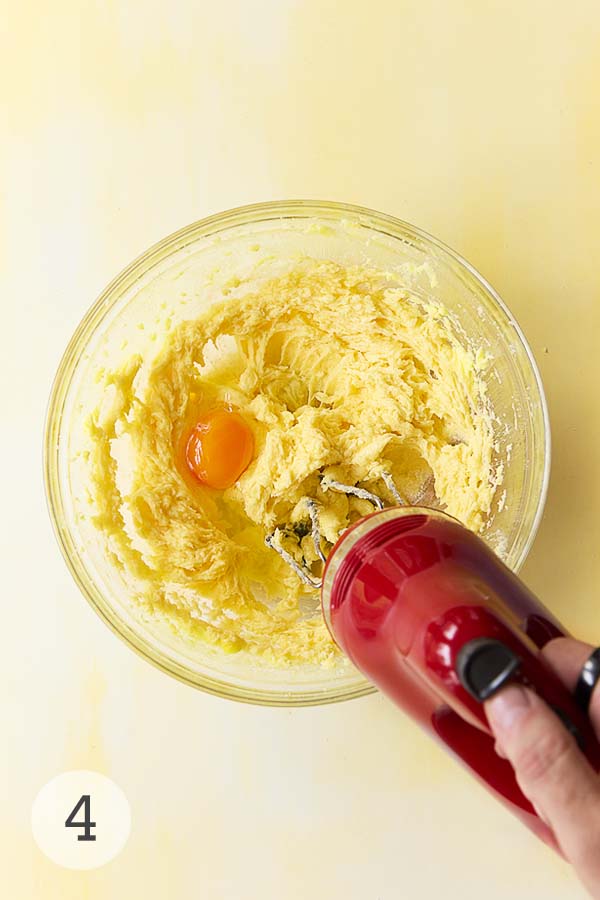
- Beat in the softened butter until the mixture is light and fluffy, then add the eggs one at a time. This creates a rich, airy batter that bakes into a beautifully tender crumb.

- Fold the flour mixture into the batter with a spatula. Take your time—this keeps the crumb tender and avoids overmixing.
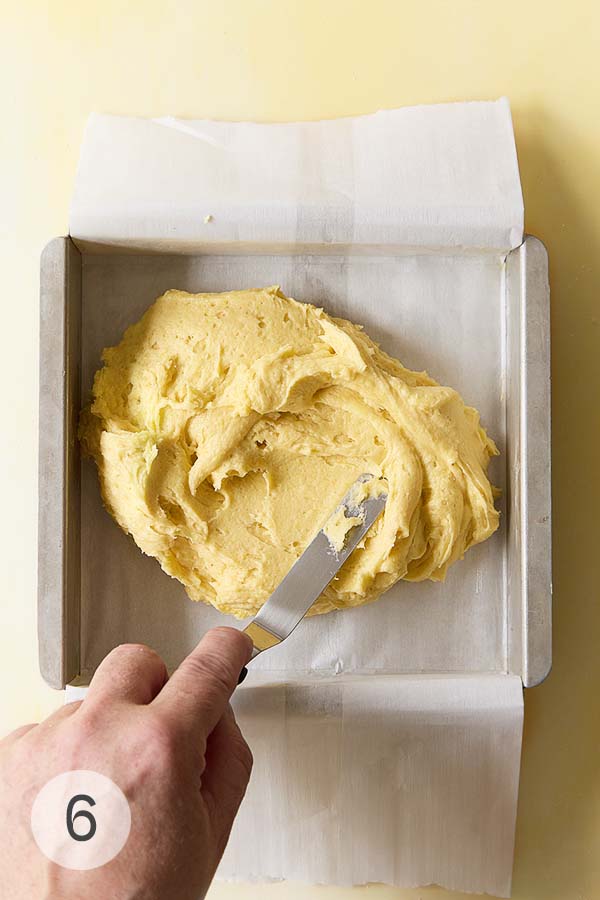
- Scoop the thick batter into the prepared pan and smooth the top with an offset spatula or the back of a spoon. It doesn’t need to be perfect—just even.
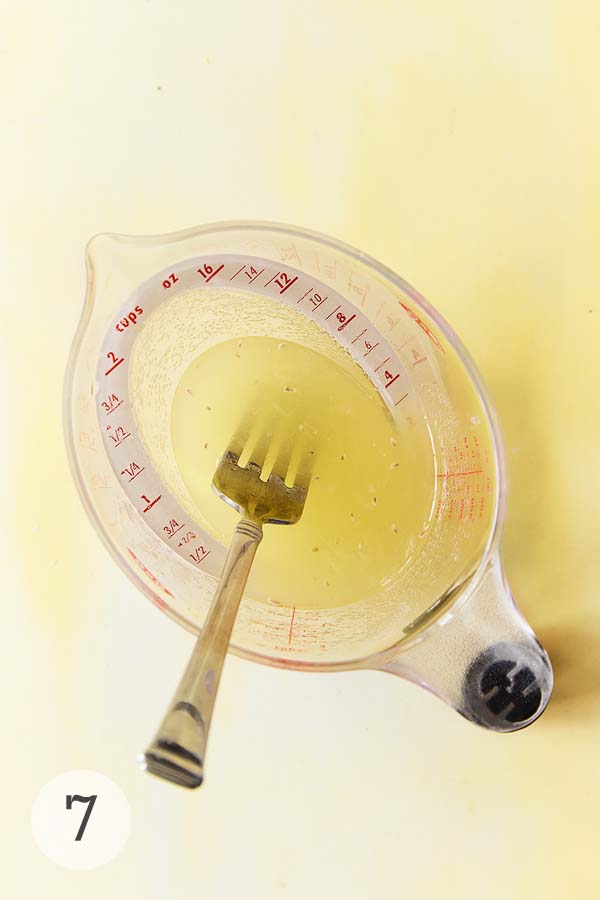
- Stir the lemon juice and sugar in a measuring cup. This mixture becomes the sweet-tart magic that soaks into the warm cake.
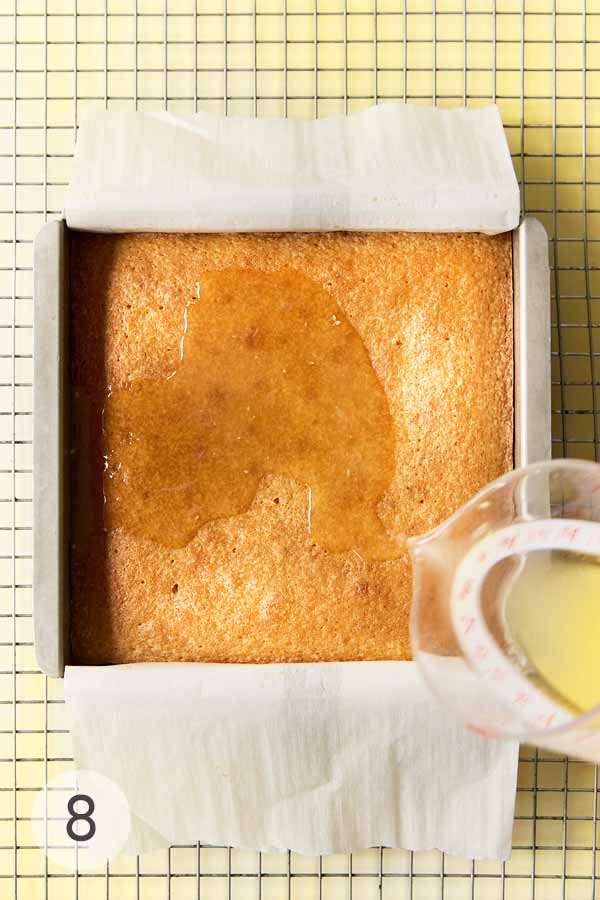
- Prick the warm cake all over and pour the syrup evenly across the surface. It’ll soak in slowly, creating that iconic crunchy top.
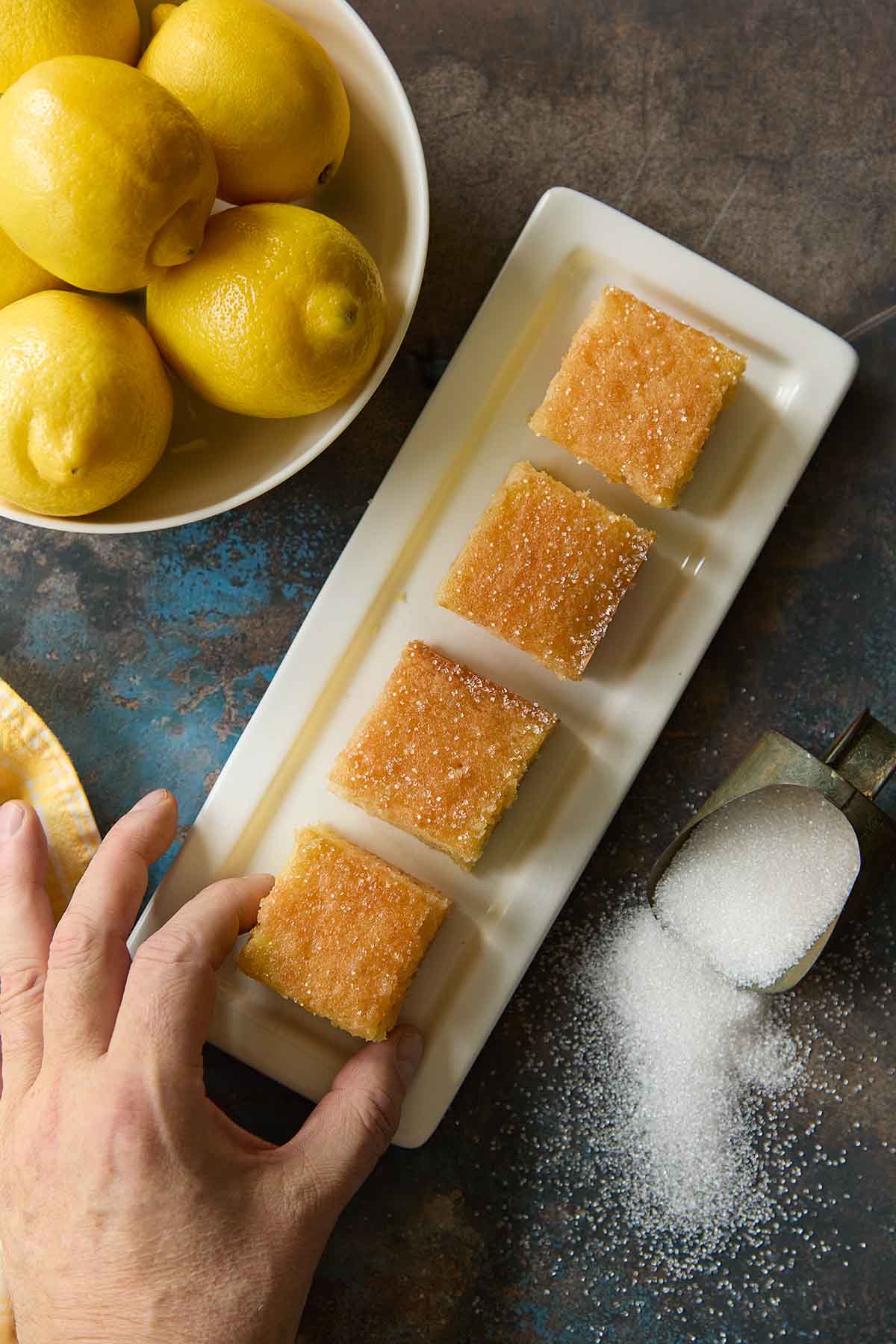
Common Questions
The terms are often used interchangeably, but there are subtle but important differences—and if you’re baking a lemon drizzle cake with a tender crumb, it matters.
Room temperature butter typically means butter that’s been out long enough to lose its chill but still feels cool to the touch. It should be 65°F to 68°F (18°C to 20°C)—soft enough to press a finger into, but still holding its shape with no shine or grease.
Softened butter, especially for creaming with sugar, needs to be a touch warmer: ideally 68°F to 72°F (20°C to 22°C). That’s when butter is at its most cooperative—pliable, spreadable, and perfect for whipping in air so your cake bakes up light and fluffy.
👉 Pro tip: If your butter is warmer than 75°F (24°C), it’s likely too soft. It’ll look shiny or greasy and won’t cream properly, which can lead to dense or greasy results.
The easiest test? Press your finger in gently:
❧ If it leaves a clean dent and the butter still holds its shape, you’re good to go.
❧ If it collapses like it’s had a rough day, pop it in the fridge for 5 to 10 minutes.
Cake flour has a lower protein content than all-purpose flour, which gives this lemon drizzle cake its light, plush crumb. It’s one of the reasons the texture feels so soft and tender, rather than dense or chewy.
If you only have all-purpose flour, you can substitute—but expect a slightly firmer, more rustic texture. To get closer to the original crumb, measure out 1⅓ cups (170 g) all-purpose flour, remove 2 tablespoons (16 g), and replace with 2 tablespoons (16 g) of cornstarch. Then sift the mixture once or twice to lighten it.
It’s one extra step—but it makes a big difference. Rubbing the zest into the sugar with your fingers releases essential oils that give the cake its bold lemon flavor. The sugar granules act like tiny scrubbers, drawing out all those fragrant oils and binding them to the sugar so the lemon essence is evenly carried through the batter.
Simply stirring the zest into the wet ingredients later won’t create the same deeply infused flavor—and your kitchen won’t smell nearly as divine
This part is essential to what makes a lemon drizzle cake—not just a lemon glazed cake. Pouring the lemon syrup over the warm cake helps it soak deep into the crumb while the cake is still soft and porous. It locks in moisture and creates that signature tangy layer just under the surface.
Letting the cake cool too much before drizzling can cause the syrup to sit on top and run off the sides, rather than seeping in. The goal? A moist, citrusy crumb and a subtly crackly top that’s sweet, tart, and a little sparkly if you use sanding sugar.
Usually, it comes down to one of three culprits: overbaking, overmixing, or not enough moisture. This cake gets its tender, plush texture from sour cream and cake flour—but it needs a light touch. To keep things moist and delicate:
🍋 Bake just until a skewer comes out clean—no longer.
🍋 Gently fold in the dry ingredients instead of beating them.
🍋 Pour the lemon syrup over the cake while it’s still warm so it can soak in fully.
Even one of those things out of whack can lead to a dry or crumbly texture instead of the soft, lemony dream you’re after.
Pro Tips
- A Microplane gives finer zest that releases more oils. Rub it into the sugar with your fingers to intensify the citrus kick.
- After the 5-minute rest in step 8, run a knife around the cake before pouring over the syrup. This prevents pooling around the edge and lets some of that bright lemon flavor to coat the sides.
- Reach for demerara sugar instead of sanding sugar for a deeper sweetness and bolder crunch. The Food Lover’s Companion states that demerara sugar is a type of raw sugar with large crystals that comes from the Demerara area of Guyana. It has a bit of a molasses flavor, which works well with the lemon.

Serving Suggestions
Serve the lemon snack cake with whipped cream, fresh berries, or a drizzle of raspberry coulis. A mint sprig would be lovely, as would a few curls of candied lemon or orange peel for flair. boo-yah!
Storage & Reheating
Room Temp
If you somehow have leftovers (I’m impressed), store the cake in an airtight container at room temperature for up to 3 days.
Freeze
Want to make it ahead? Let the cake cool completely—without pouring over the lemon drizzle. Then wrap it tightly in plastic and foil and freeze for up to 2 months. Thaw it overnight on the counter like a civilized person.
Reheat
To bring it back to life, reheat the cake in a 325°F (160°C) oven for 10 to 15 minutes—just until it’s warm and the kitchen starts smelling like you baked it from scratch (again). Then, poke it all over with a skewer and pour on a batch of warm lemon syrup. Voilà: revived, rehydrated, and ready to wow.
Made This Lemon Drizzle Cake?
Spill the Tea.
If you baked this lemon drizzle cake, I’d love to hear what you think! Leave a review, a star rating, and your best cake photo. Did that crunchy lemon topping hit the mark? Was it tart enough for you? I read every comment, and your feedback helps others—and me!–David
This is a wonderful drizzle cake recipe. I tried it a week ago, and my family really loved it.
vigilon

Lemon Drizzle Cake
Ingredients
For the cake
- ¾ cup (12 tablespoons) unsalted butter, softened, plus more for the pan
- 1 cup granulated sugar
- 2 tablespoons lemon zest, from 2 lemons
- 3 large eggs
- 2 tablespoons sour cream, or whole milk
- 1 ⅓ cups cake flour
- 2 teaspoons baking powder
- ½ teaspoon table salt
For the lemony topping
- 4 tablespoons granulated sugar
- freshly squeezed juice of 1 lemon, (3 tablespoons [45 ml])
- sanding sugar, (optional), for decorating
Instructions
Make the lemon cake
- Crank the oven to 350°F (175°C). Butter an 8-inch square cake pan and line it with parchment paper.
- Combine the 1 cup granulated sugar and 2 tablespoons lemon zest in a large bowl. Rub them together with your fingertips until the sugar is fragrant and pale yellow from the lemon oil.
- Drop in the ¾ cup (12 tablespoons) unsalted butter and beat with a hand mixer on medium speed until lightened, about 3 to 4 minutes.
- Beat in the 3 large eggs, one at a time, until combined, about 45 seconds each. Scrape down the sides of the bowl after each addition. Beat in the 2 tablespoons sour cream.
- Whisk together the 1 ⅓ cups cake flour, 2 teaspoons baking powder, and ½ teaspoon table salt in a separate bowl. Fold the dry ingredients into the butter-sugar mixture just until no streaks of flour remain. The batter will be thick.
- Spoon the batter into the prepared pan and smooth the top evenly with an offset spatula or the back of a spoon.
- Bake the lemon cake until golden, well-risen, and a skewer inserted in the center comes out clean, about 25 minutes.
- Transfer the pan to a wire rack and immediately prick the top of the warm cake all over with a skewer. Let the cake cool for 5 minutes.
Add the lemon-crunch topping
- Stir the 4 tablespoons granulated sugar into the freshly squeezed juice of 1 lemon until mostly dissolved, then pour the syrup evenly over the warm cake.
- Sprinkle 1 to 2 tablespoons of sanding sugar or granulated sugar evenly over the surface of the cake for a sparkly, slightly crunchy finish. Let the cake cool completely in the pan. Cut into small squares to serve.
☞ TESTER TIP: Store the cake in an airtight container at room temperature or in the refrigerator for up to 3 days.
Notes
- Boost lemon flavor with microplaned zest—A Microplane gives finer zest that releases more oils. Rub it into the sugar with your fingers to intensify the citrus kick.
- Avoid soggy edges—After the 5-minute rest, run a knife around the cake before pouring the syrup. This lets it soak in from the top instead of pooling at the sides.
- Swap your sugar for extra crunch—Try demerara sugar instead of sanding sugar for a deeper sweetness and bolder texture. Or top with a few curls of candied lemon peel for flair.
- Dress it up for company—Serve with whipped cream, fresh berries, or a drizzle of raspberry coulis. A mint sprig? Chef’s kiss.

An LC Original
View More Original RecipesNutrition
Nutrition information is automatically calculated, so should only be used as an approximation.
Recipe Testers’ Reviews
This straightforward, minimal-ingredient lemon snack cake is super moist. My husband is a huge lemon fan, so I always want his opinion on anything lemony. He loved this cake and kept going back for more.
I creamed the sugar and butter for a full 4 minutes, added the eggs one at a time, and beat for 1 minute after each addition, scraping down the bowl as well. I used 1 tablespoon of lemon zest that I keep handy in the freezer.
The batter was quite thick and took a little coaxing to get into the corners. Once baked, the parchment sling made it easy to remove from the pan. My cake took 24 minutes of baking and was beautifully golden brown with a springy top.
I let the cake cool for a couple of minutes before drizzling. The zest in the cake with the lemon drizzle is a perfect lemony combination. This cake is best eaten the day it is baked. The second day it became a little dense and less moist. Popping into a microwave for a few seconds brought it back.
Mmm…a lemon dessert that isn’t the ubiquitous, albeit delicious, lemon bar. This will be a useable and user-friendly addition to my dessert repertoire, in part because it isn’t complicated to make, in part because it has a lovely lemon flavor and a fine and unexpected texture, in part because it’s a dessert that will play well throughout the year with many different cuisines, and because it keeps well and can therefore be made in advance—a lovely advantage for meal planning in the lives of busy people.
I tried the lemon drizzle cake two ways, and both worked. First, I stored it in the fridge after completing it, and it was fine when brought out to serve. Second, which I liked even better, was Renee’s suggestion in the comments to bake, then freeze, then drizzle the cake after thawing and right before serving. This preserved the crisp sugary crust on top that’s such a perfect counterpoint to the clean, uber-lemony flavor of this cake.
My friend Douglas commented that his favorite part of the cake was the sugary crunch on top, though he also noted that he loved its light and refreshing taste. I liked the simplicity and elegance of its presentation. Another friend thought it would be enhanced by whipped cream; he suggested a light sprinkle of cinnamon atop the whipped cream.
A Quick Heads-Up (Updated April 2025): This recipe got a total makeover! I’ve completely updated my lemon drizzle cake from the original 2010 post, as I’m much happier with this new version. You might spot some older comments below – I’ve kept the ones that still capture the general love for a great lemon drizzle, even if they were posted before this specific recipe update!

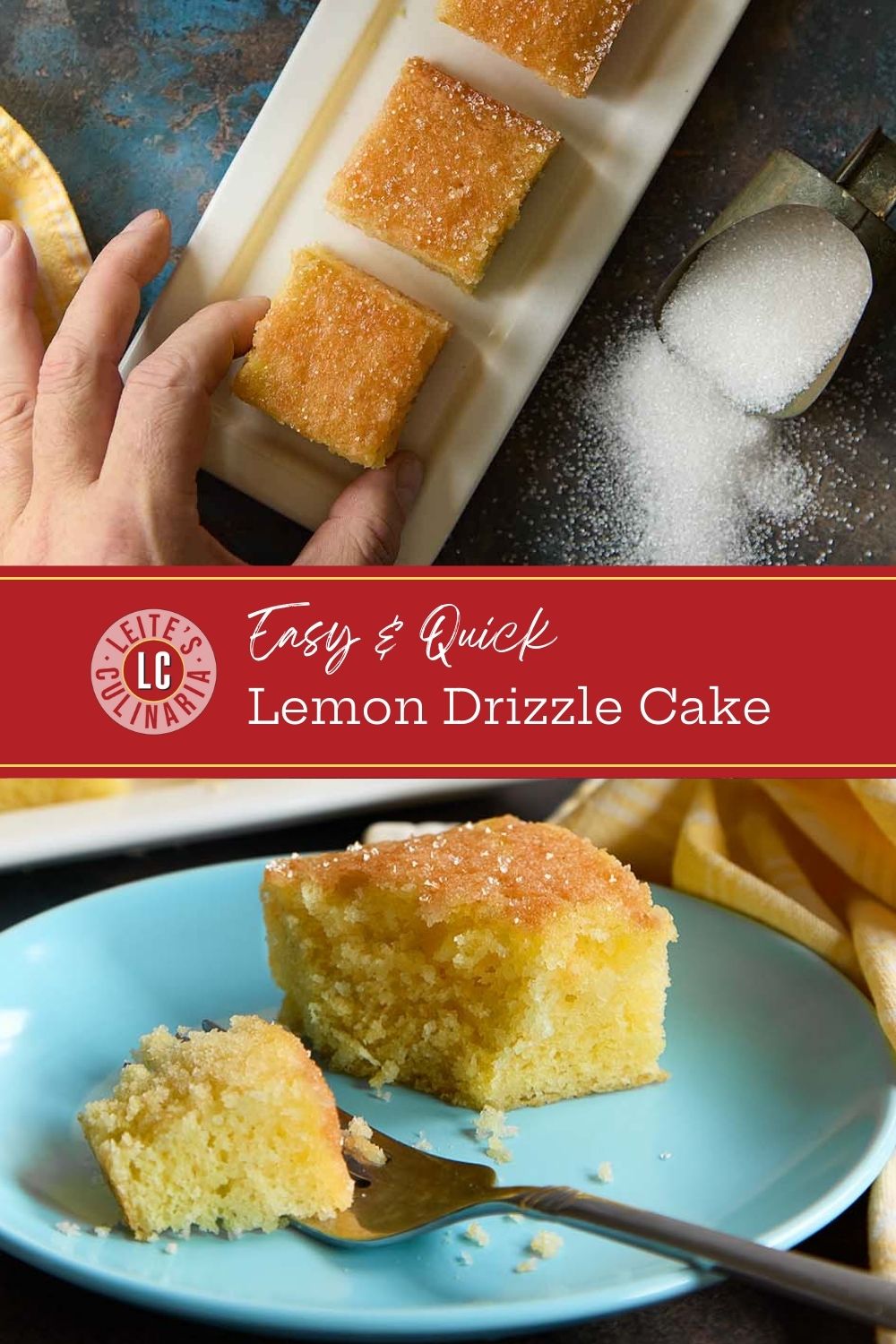



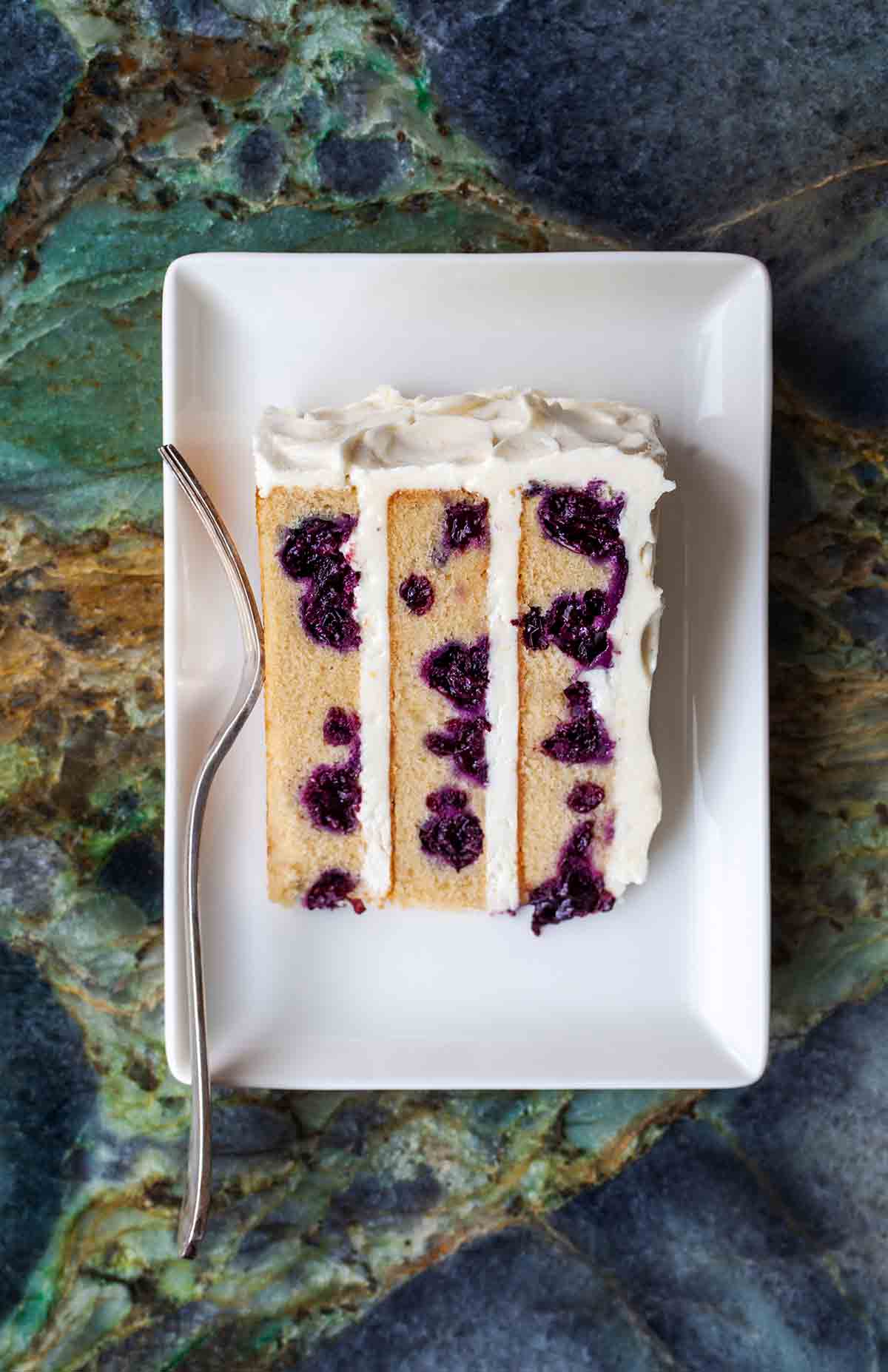













Hmmm, do you know how Canadian flour compares to English or American flour? We can get self rising flour here, so would you be so kind and let me know the amount I would use? Greatly appreciated!
I love your website btw❤️
Carol, thank you so much for the kind words—and I’m thrilled you’re enjoying the site!
You absolutely can use self-rising flour, but here’s why I recommend sticking with my formula: Self-rising flour is typically made from all-purpose flour, which has a higher protein content—about 10% to 12%. That’s the same range you’ll find in both Canadian and American all-purpose flours (fun fact: a lot of U.S. flour is made from Canadian hard red winter wheat).
The recipe, however, calls for cake flour, which comes in around 6% to 8% protein and and similar to British plain flour. That lower protein is what gives the cake its wonderfully light, tender crumb. So even if you use self-rising flour, you likely won’t get the same delicate texture.
That said, if you’re still keen on using self-rising flour, you can give it a go! Just swap in 1 1/3 cups of self-rising flour and omit the baking powder and salt. It won’t be quite as light, but it’ll still be lemony and lovely.
And if you do try both versions, I’d love to hear which one you prefer!
Very similar to Maida Haiters East 62nd lemon cake which is a staple of mine because it is delicious and was my moms favorite.
Janice, you made my week! I love Maida Heatter. Thank you for that. I’m linking to her books for those who might not be acquainted yet!
This cake has a nice lemony flavor and is fairly easy to make. I also added a touch of natural lemon extract in both the cake and the topping.
The size of the cake was closer to a lemon bar. I could see doubling the ingredients to get a thicker cake. Also, the topping is a nice surprise. It did not initially look like it would work; however, when the cake was completely cooled, the topping disappears from sight but you get a little crunch and flavor when you take a bite.
Thanks, Adrienne. I’m so pleased that you enjoyed it.